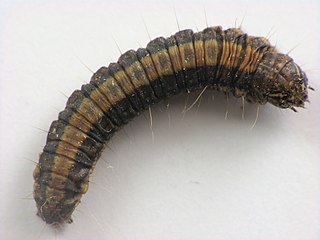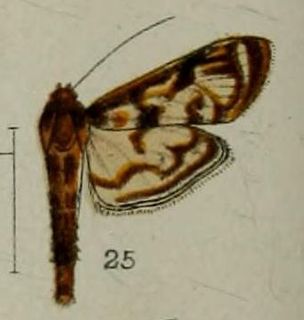
Xylomyidae is a family of flies known commonly as the wood soldier flies. They are xylophagous and are associated with dead or dying wood.

Hypena is a genus of moths in the family Erebidae. It was first described by Franz von Paula Schrank in 1802. These non-migratory moths overwinter as pupae and almost never estivate as adults.

Omiodes is a moth genus in the family Crambidae. Several species are endemic to Hawaii.

Bradina is a genus of moths of the family Crambidae.

Glyphodes is a genus of moths of the family Crambidae described by Achille Guenée in 1854.

Herpetogramma is a genus of moths of the family Crambidae described by Julius Lederer in 1863. It currently comprises 106 species and is found in North America, Eurasia, Australia, New Zealand, Central and South America. Of the few species where host plants are known, the larvae mostly feed on grasses.

Lamprosema is a genus of moths of the family Crambidae described by Jacob Hübner in 1823.

Parapoynx is a genus of moths of the family Crambidae described by Jacob Hübner in 1825.

Phostria is a genus of moths of the family Crambidae.

Syllepte is a genus of moths of the family Crambidae.

The Chrysauginae are a subfamily of snout moths. They are primarily Neotropical and include about 400 described species.

The Epipaschiinae are a subfamily of snout moths. More than 720 species are known today, which are found mainly in the tropics and subtropics. Some occur in temperate regions, but the subfamily is apparently completely absent from Europe, at least as native species. A few Epipaschiinae are crop pests that may occasionally become economically significant.

The South Carolina School for the Deaf and the Blind is a school in unincorporated Spartanburg County, South Carolina, United States, near Spartanburg and with a Spartanburg postal address. It was founded in 1849 by the Reverend Newton Pinckney Walker as a private school for students who were deaf. The School for the Blind was established in 1855, and the school became state funded in 1856.

Rhimphalea astrigalis is a small moth in the family Crambidae that is found in the mountains of Borneo and Thailand. The species was first described by George Hampson in 1898.
Rhimphalea sceletalis is a small moth in the family Crambidae that is found in Queensland in Australia and in Papua New Guinea. The species was first described by Julius Lederer in 1863.
Rhimphalea heranialis is a moth in the family Crambidae. It was described by Francis Walker in 1859. It is found in New Guinea, Peninsular Malaya and Borneo.

Rhimphalea ochalis is a moth in the family Crambidae. It was described by Francis Walker in 1859. It is found in India, West Malaysia, Borneo, Sumatra, and Indonesia (Java). in lowlands to montane forests (1000 m).
Rhimphalea trogusalis is a moth in the family Crambidae. It was described by Francis Walker in 1859. It is found in the Himalayas, Assam, India, the Philippines, Borneo and Sulawesi.

Margaroniini is a tribe of the species-rich subfamily Spilomelinae in the pyraloid moth family Crambidae. The tribe was erected by Charles Swinhoe and Everard Charles Cotes in 1889.














